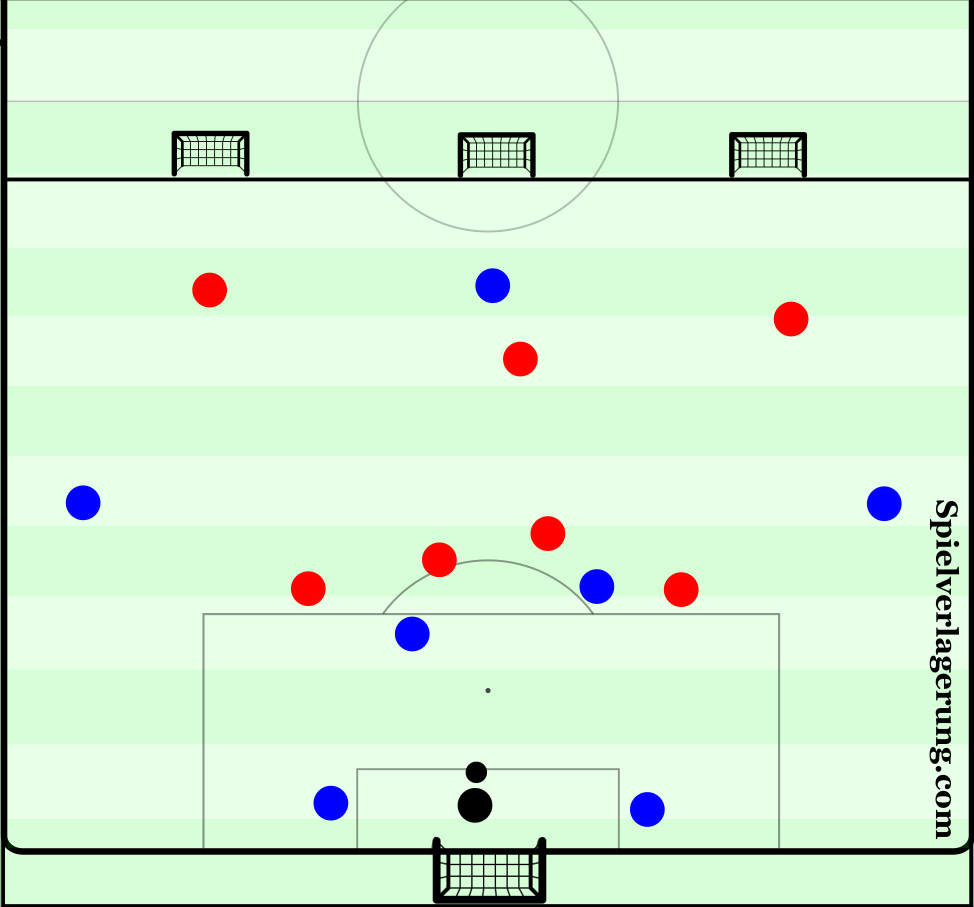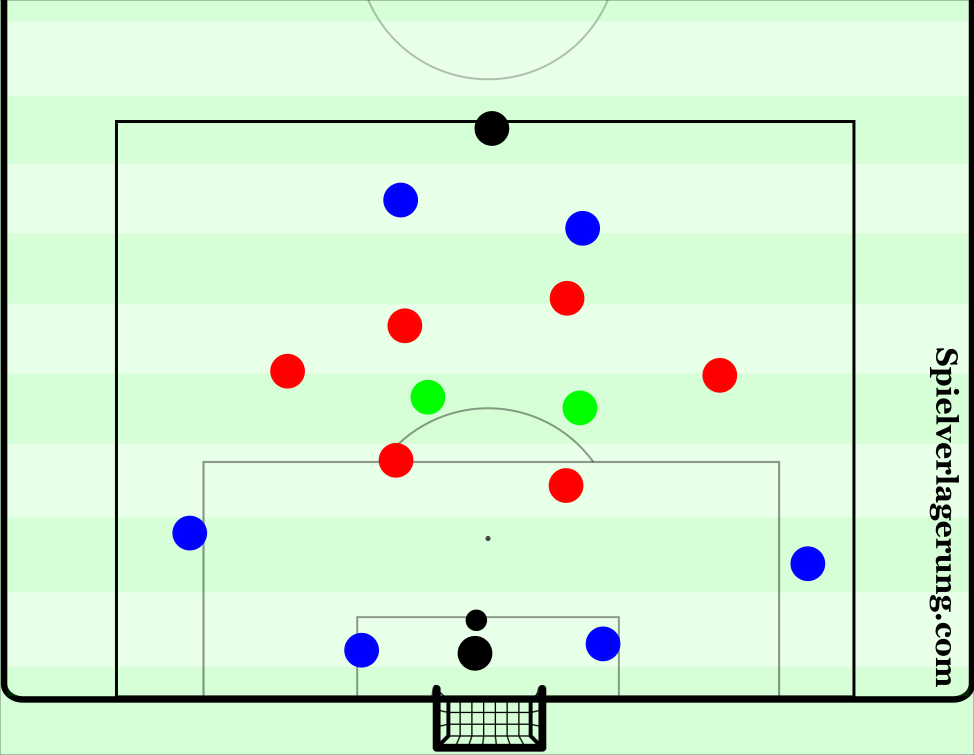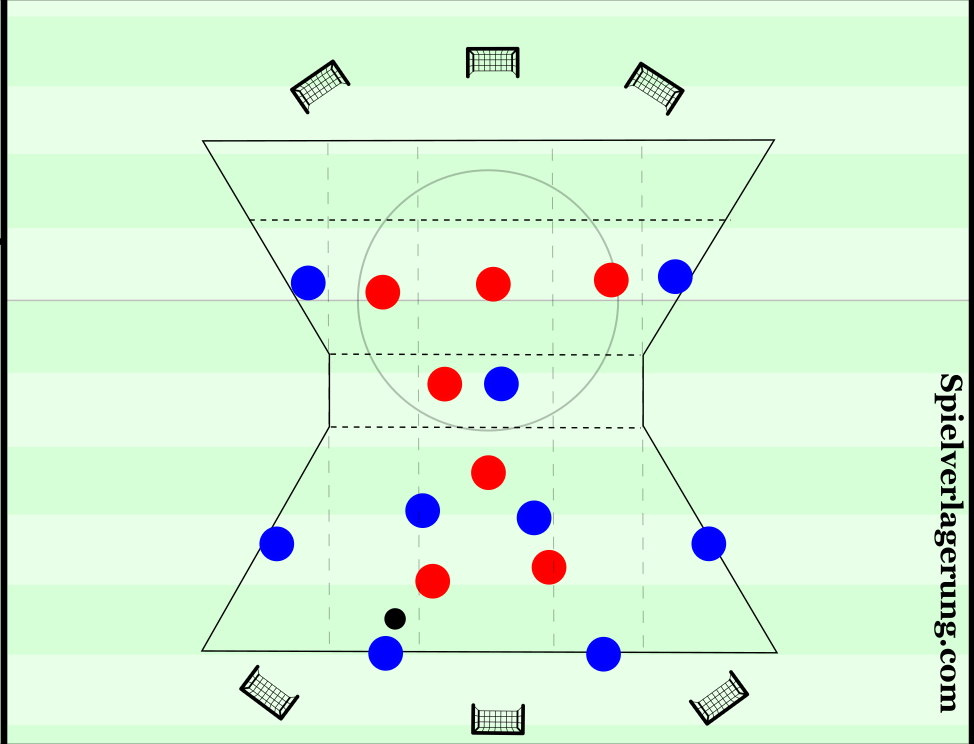Sassuolo’s Positional Play System
Roberto de Zerbi’s team show us one of the most interesting positional play approaches recently. The concept of positional play became very popular these days, still a lot of coaches and teams misinterpret it and just throwing the concept around without a deeper understanding. Although, Sassuolo is a good example for the opposite.
System
Sassuolo is playing in a 4-2-3-1 system, with the wingers mostly staying out wide, whilst the full-back are deep & inside in the circulation phase. This is the basic positioning, opposed to the usual 4-2-3-1 approaches, where a central-midfielder usually drops next to or between the centre backs, the full-back moves higher and the winger moves inside – wide rotation. Generally this is not the case for Sassuolo, who try to find the central-midfielders/#6s behind the oppositional 1st line, and circulate through the 4 defenders, although if they struggle to find the central-midfielders inside, one of them drops wide and they make the aforementioned wide rotation. The advantage of that is on one hand to allow the central-midfielder/#6 to play facing the oppositional goal, plus to manipulate the oppositional wide cover, possibly forcing shifting issues. The wide rotation might also be a trigger for the central attacking-midfielder/#10 to drop deeper, to maintain having 2 options inside behind the oppositional 1st line. Generally the attacking-midfielder/#10 stays higher between the lines, starting from the centre and moving to either halfspace to offer connection for the central-midfielders/#6s one line higher or for the wingers -diagonally inside or underlap runs. In order to offer connections wide the centre-forward is very halfspace-oriented, occupying the space between the oppositional CB-FB, mostly to make diagonal runs to stretch the last line or to drop deeper and offer a diagonal option between the lines. A possible rule here is that the centre-forward and the central attacking-midfielder/#10 are not on the same side to create more optimal spacing between the lines. Since the AM/#10 is mostly moving towards the right side from the centre, the centre-forward is occupying the left halfspace with a higher frequency.

Central-focus
The main goal is manipulate the oppositional lines through the centre, using the central-midfielders/#6s inside, behind the 1st line. The dynamics might differ if playing against a 1 or 2-men 1st line, but the basic principle is the same. In order to create optimal central connections the centre-backs are positioning themselves relatively close to each other, so they can maintain a good connection, plus able to find different ball options by passing to each other on the shorter distances. This allows them to move the oppositional lines to create access to the central-midfielders/#6s. As the centre-backs are on the ball it’s almost always the ballfar CM/#6 who moves towards them diagonally, whilst the ballnear CM/#6 stays in position. Due to that, space opens on the near side, and a more optimal central dynamics is created. Besides, the CMs/#6s central position also opens the halfspaces, to offer more accessible ball options, when the CBs have the ball.
Against a 1-men 1st line the centre-back will more likely face a pressure coming from sideways, guiding into a possible trap, by allowing him to drive forwards. In this case, both central-midfielders/#6s might offer an option forward & lay-off back to the ballfar centre-back, who is open behind the pressing player. If he receives a press frontally, covering the ballnear CM, it will open the ballfar access. Also, to reduce the 1st line cover the centre-backs often drive forward or orient themselves on the ball diagonally, to basically pin the oppositional forward inside & in a decision-crisis – no matter which space he is closing, a forward option will be open.

Against a 2-men 1st line the situation is slightly different, but the principles are the same. When the centre-back has the ball, the ballnear central-midfielder is usually a bit wider -to be able to receive next to the oppositional 1st line-, whilst the ballfar central-midfielder is inside, behind the 1st line. The latter forces the 1st line to adjust, as if they stay wider, the centre will open up, if they are narrower, wide zones become more accessible. A possible defensive reaction to that by the 1st line is to cover the central-midfielders/#6s with their shadows, when the centre-backs have the ball, to prevent any inside passes. This although leaves more space/time on the ball for the centre-backs to find the wingers wide or even the CF-CAM in the halfspaces. Although, relying on to this would make the circulation “easy to read” -and U-shaped mostly-, therefore countering that the wide rotation – CM move wide, FB high, W inside- is a usual strategy to manipulate that defensive cover.

Wide-positioning
As mentioned before, the full-backs generally stay deep and a bit inside, whilst wingers staying wide, except when they make a wide rotation -CM moves wide, FB high, W inside. The full-backs general role is to highly participate in moving the ball horizontally, or to find connection with the wingers, who mostly receive wide, not only from the full-backs, but directly from the centre-backs as well. Situations might occur, where the halfspace in depth -between the lines- is not occupied, which is the trigger for the full-backs to move up and make runs from depth. Depending on where they are positioned, when the wingers receive the ball, they either move the make the over- or underlap -obviously, if they are more inside, they will move for the underlap, if wider, go for overlap. A simple inside movement from the full-backs might also occur, based on the same trigger -halfspace depth unoccupied- to open space for the winger to receive directly from the centre-backs.

Another “type” of wide positioning occurs, when making the wide rotation -then the staggering becomes a 3-2-5. As the winger moves inside, it might create spacing issues with the attacking-midfielder/#10 to distribute the space optimally. Therefore the rule for the winger is to occupy the space between the oppositional winger-central-midfielder -basically the halfspace-, and for the attacking-midfielder/#10 is to be 1 lane inwards, between the oppositional central-midfielders. If playing against a 5-3-2 with a 3-men 2nd line, the rule might be for the winger to be in the halfspace & for the CAM/#10 to be between the central-midfielder – defensive-midfielder.

In some situations the ballnear central-midfielder/#6 moves higher between the lines to offer an inside option for the ballnear wide winger, which could be a great addition for their wide movements, if they’d used it on a regular basis. When ball goes wide the CMs usually stay in position, rarely moving higher, although as either the centre-forward or the attacking-midfielder/#10 is occupying the halfspace in depth -maybe even running behind-, it opens spaces between the lines, which could be exploited well by the CMs.
Attacking third scheme
Due to the basic positioning, the progression to the attacking third happens mostly at the wide zones – since if they are able to penetrate through the centre, the attack is much more dynamic to maintain the positional advantage and immediately attack the last line. When the ball goes wide and the winger can’t break through, he circulates the ball back and moves inside & the ballnear full-back moves up. In order to circulate the ball the central-midfielders shift towards the ballnear side, whilst the ballfar full-back moves inside – connection to circulate, plus to offer cover for a possible ball-loss/rest-defense – and the ballfar winger stays wide. This positioning basically creates a 2-3-5 staggering in the attacking third. As mentioned earlier, the centre-forward and the attacking-midfielder/#10 are both halfspace oriented, which occurs even more in the attacking-third, as the centre-forward often makes inside runs between the oppositional FB-CB to stretch the last line or to create crossing opportunities. The advantage of that is to pull out a CB wider, reducing the cover inside the box or simply to create a dynamical or positional advantage whilst making a run behind. There is also a huge emphasis to make diagonal runs behind the last line from these positions – the oppositional centre-backs blind-side.

Build-up under pressure
To build-up from goal-kicks they usually mix 2 setups: a version, if the oppositional press is very opponent-oriented/basically leaving equal numbers as attackers at the back -no free-man-, and a version, if the opponent leaves +1 at the back -zonal-oriented.
If there is no free-man at the back, then they change the staggering upfront, creating a 2-2 -attacking-box- with the CF-CAM deeper in the halfspace & 2 Ws higher and wide. The advantage of this is to stretch the oppositional lines at the back, possibly creating a better situation to collect 2nd balls in case of a long ball. Also, there are some small adjustments to make in these situations, as the central-midfielders/#6s often stay a bit wider, to open the passing lanes towards the CF-CAM in the halfspaces. On the other hand, a centre-back might move across to receive a small lay-off from the GK, gaining space forwards -decrease distances to more optimally reach the halfspaces-, from where different accessible passing lane emerge. In this case the CB is usually looking diagonally to the ballfar halfspace.

If the opponent leaves +1 at the back, they either start the play towards the centre-backs, or towards the central-midfielders/#6s. The latter is the same solution that Napoli uses, to basically delay the oppositional 1st line pressure on the centre-backs, allowing them slightly more time/space on the ball. Another key element then is the CMs horizontal movement to offer option behind the 1st line as the CBs or the FBs have the ball. Since the 1st line have to cover that, it often reduces the cover at the centre, opening space for the GK to receive & switch or to find the dropping CMs inside, who lay-it off to either CBs. When the GK receives the ball is a general trigger for the CMs to drop towards him and offer an option.

Player-instructions
In order to utilize the principles from Sassuolo’s positional play, here are some key instructions for the particular positions, using action language -‘if then’ rules- to offer guidelines for the decision-making.
Centre-backs:
- look diagonally inside whilst on the ball – create connection with the CMs -› if access blocked inside, then look to circulate the ball using the deep FBs or the Ws wide
- maintain a shorter distance between each other
Full-backs:
- stay deeper & more inside to offer connection to circulate
- look for the winger in front whilst on the ball, or inside towards the CMs – CAM
- in the attacking third – move inside & deep, form a 3-men chain with the CMs
- if halfspace depth unoccupied, then make underlap run inside
- if halfspace depth unoccupied – but you are wider -, then make an overlap for the W
- if CM moves wide, then move high
- if CB drives forward and winger stays wider, then move inside to the halfspace, to open the wide access
Central-midfielders:
- stay inside – mostly on the oppositional central-midfielder’s inside shoulder – to open halfspaces
- if CB on the ball on your side, then stay in position or look for a lay-off towards the ballfar CB
- if CB on the ball on the opposite side, then move towards him to offer option diagonally
- if opponent closes inside lanes towards both of you, then move out wide on the near side, move inside on the far side
- if opponent closes inside access so ball goes wide, then move higher behind the oppositional 2nd line
- if ball progresses to attacking third, then shift towards the ball to offer option to circulate
Wingers:
- stay wide to receive to feet
- when ball goes wide to the FBs – make body-feints to separate/create distance from the oppositional FB
- if you can progress higher but can’t find any forward options, then circulate the ball back and move inside
- if ball progresses higher on the far-side, then stay wide and wait for diagonal switches
- if CM moves wide on your side, then move inside and look for underlap runs
Attacking-midfielder:
- stay at the centre, between the lines, mostly move towards the right side slightly
- start from the centre, if the CB can find the CMs higher who can turn, then move to that side, if he can’t turn, rather stay centrally
- if ball goes wide towards the Ws, then look for diagonal inside passes or underlap runs
- if ball progresses on the opposite side, look for runs between the CB-FB area
Centre-forward:
- move wider, occupy the zone between the CB-FB, even drop deeper in the halfspace
- optimally be on the opposite side of where the CAM is
- if ball goes wide towards the Ws, then look for underlap runs
- if ballfar CB can drive forward, then drop deeper to offer a diagonal passing option
Training drills
Some ideas for possible training drills and designs based on Sassuolo’s positional play.






2 Kommentare Alle anzeigen
Fridolin January 23, 2023 um 11:36 pm
Really great on De Zerbi’s Sassuolo!
Thanks
CarlosGarcia09 May 3, 2020 um 4:16 pm
Superb article Istvan, congratulations.
Sassuolo has a very good and modern style of play, they use the roles of the CMs and the halfspaces with logic, I love watching them.
A question I always have as analyst/coach is how to create a plan to play against the teams I analize. For me is the most difficult aspect in tactics, what do you think? How would you play against Sassuolo?
You can add a point in your articles for answering this question (it is only an idea, your articles are really good).